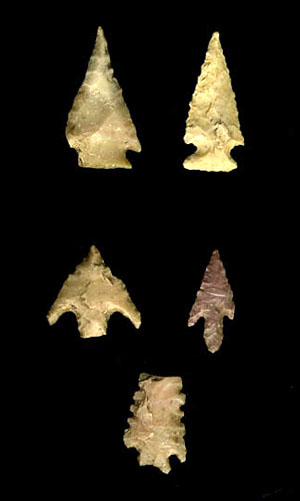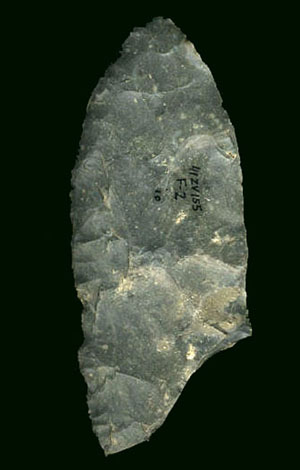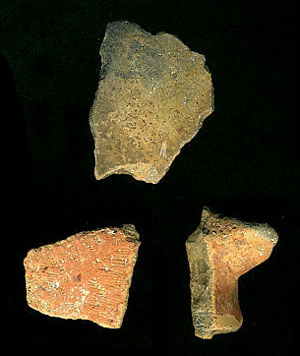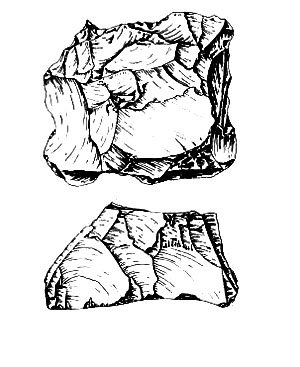Tortuga Flat
The Tortuga Flat site (41ZV155) is significant as one of the few reported Late Prehistoric/Early Historic campsites that reveals traditional lifeways of the region’s indigenous peoples on the “eve” of the Spanish entrada. Radiocarbon assays indicate the Zavala County site was used in the 15th and 16th centuries.
Spanish accounts tell us this area was frequented during the 1700s by the Pacuache Indians and other hunting and gathering groups who spoke the Coahuilteco language. The 1709 diary of the Spanish priest, Felix Isidro de Espinosa, who traveled from Mission San Juan Bautista on the Rio Grande to San Antonio and beyond (Espinosa-Olivares-Aguirre expedition), tells of encounters with the “Pacuasian” (likely Pacahuache) peoples who were hunting mice (in either present-day Dimmit or Zavala county). Spanish records from the missions at Guerrero, Mexico, tell us that these peoples, numbering perhaps 400 in all during the early to mid-18th century, moved from camp to camp, sheltering themselves in lean-tos of branches covered with grasses. Another account records a group of Pacahuache hunting bison near the area of present day Del Rio. Pacuache women often decorated the hides with red and yellow painted designs to trade to the Spaniards and others at the missions.
Evidence from the Tortuga Flat site supports these observations. During 1972-1973, avocational archeologist T. C. Hill of Crystal City conducted test excavations at the site, uncovering what he described as a compact zone of cultural materials. Artifacts included a variety of chipped stone tools including Perdiz and Scallorn arrow points, bone-tempered ceramics, and animal bones. One Cuney arrow point hints at very late contact, perhaps trade, with East Texas native groups. Although cultural chronologies for the Edwards Plateau region indicate that Scallorn and Perdiz points were used in successive time periods (termed the Austin and Toyah intervals, respectively), such a demarcation is not apparent in some south Texas sites. Tortuga Flat and other sites (eg., Pampopa-Talon Crossing in Medina County and Skillett Mountain in McMullen County) suggest use of the two point types may have overlapped. Perhaps the most striking example of late occurence is a fragment of a Perdiz arrow point chipped from glass found at Mission San Antonio de Valero (the Alamo).
Both tool manufacturing and resharpening took place at the Tortuga Flat site, based on the finding of cores, hammerstones, and trimming flakes. Cores were worked efficiently to make the most use of the small local chert cobbles. One core appeared to have been reduced using blade-core technology typical of late-period Toyah folk; the technique was also used by some Indian groups in mission settings, including those at Guerrero. A knife segment, resharpened by alternate beveling, was made on a distinctive fine-grained, dark gray material resembling Georgetown chert. Ultra-violet scanning of this artifact and a unifacial tool suggests the material for both was Edwards chert from central Texas.
The presence of beveled knives and end scrapers in sites dating after A.D. 1300 shows the importance of bison processing in a widespread exchange network on the southern Plains and adjacent areas. The knives were used to cut the hides during skinning and the end scrapers used to remove hair and further dress the hides.
From this array of evidence we can imagine a busy encampment along the banks of Tortuga Creek and nearby environs, where hunters procured deer, antelope, and other large mammals, as well as coyote, rabbit, fox, racoon, rats, and mice, and a variety of birds.Women and children gathered land snails from brushy prairies and aquatic resources from the creek, including freshwater mussels, fish, and turtles. They no doubt also gathered a variety of plant foods, which they processed with choppers and grinding tools. Based on a variety of chipped stone scraping and cutting tools, the women processed animal hides at the site. They also fashioned thin, coiled pottery, probably using local clay from nearby sources tempered with crushed animal bone, some of which was first burned. Hunters also collected local chert and knapped stone tools and resharpened their weapons at the site.
Researchers, including UT-Austin ethnohistorian Dr. T.N. Campbell, believe that at least some of the evidence from the Tortuga Flat site can be attributed to the Pacuache Indians. Spanish records show that Pacuache families also lived at the Gateway missions at Guerrero. Attempting to discern correlations between the two occupations, archeologist Betty Inman compared the toolkits from both sites. She found that, while specific artifacts could not be directly associated with the Pacuache, certain Late Prehistoric and prehistoric tools were not continued into the mission setting. Perhaps this was due to changing technology (introduction of Spanish metal tools) or because of cultural standardization of the natives crowded in Indian housing at the missions.
For more on the Pacuache Indians and others of the area, see the TBH exhibit, The Gateway Missions: Native Conversions on the Rio Grande www.TexasBeyondHistory.net/
gateway/index.html.
Credits and Sources
This exhibit is based on Archeological Investigations at the Tortuga Flat Site (41ZV155), Zavala County, South Texas, by Betty Inman, T.C. Hill, Jr., and Thomas R. Hester, published in 1998 for the Bulletin of the Texas Archeological Society 69:11-33. Additional sources include:
Hall, Grant D., Thomas R. Hester, and Stephen L. Black
1986 The Prehistoric Sites at Choke Canyon Reservoir, Southern Texas: Results of Phase II Archaeological Investigations. Choke Canyon Series 10. Center for Archaeological Research, the University of Texas at San Antonio.
Hester, Thomas R. and T. C. Hill, Jr.
1975 Some Aspects of Late Prehistoric and Protohistoric Archaeology in Southern Texas. Special Report No. 1, Center for Archaeological Research, The University of Texas at San Antonio.
Inman, Betty
1999 The Lithic Artifacts of the Native Americans at the Spanish Colonial Missions at Guerrero, Coahuila, Mexico. Bulletin of the Texas Archeological Society 70: 363-384.
Download pdf (8.5 MB)
Lohse, John
1999 Lithics from the San Antonio de Valero Mission. Bulletin of the Texas Archeological Society 70: 265-279.





